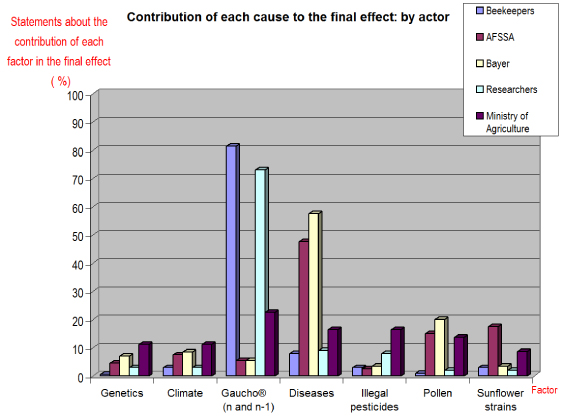
Expert explanations of honeybee losses in areas of extensive agriculture in France: Gaucho compared with other supposed causal factors
[Maxim and Van der Sluijs 2010, Environmental Research Letters]
French researchers estimate that 73% of the increased colony collapse in 1994-2004 in areas of extensive agriculture in France has been caused by imidacloprid.
Abstract
Debates on causality are at the core of controversies as regards environmental changes. The present paper presents a new method for analyzing controversies on causality in a context of social debate and the results of its empirical testing. The case study used is the controversy as regards the role played by the insecticide Gaucho®, compared with other supposed causal factors, in the substantial honeybee (Apis mellifera L.) losses reported to have occurred in France between 1994 and 2004.
The method makes use of expert elicitation of the perceived strength of evidence regarding each of Bradford Hill's causality criteria, as regards the link between each of eight possible causal factors identified in attempts to explain each of five signs observed in honeybee colonies. These judgments are elicited from stakeholders and experts involved in the debate, i.e., representatives of Bayer Cropscience, of the Ministry of Agriculture, of the French Food Safety Authority, of beekeepers and of public scientists.
We show that the intense controversy observed in confused and passionate public discourses is much less salient when the various arguments are structured using causation criteria. The contradictions between the different expert views have a triple origin: (1) the lack of shared definition and quantification of the signs observed in colonies; (2) the lack of specialist knowledge on honeybees; and (3) the strategic discursive practices associated with the lack of trust between experts representing stakeholders having diverging stakes in the case.
By systematically applying widely accepted criteria for causality, scientist were able to identify exposure to the systemic insecticide imidacloprid (a neonicotinoid used in plant protection products such as Gaucho and Admire) as the main cause for honeybee decline in the sunflower and maize area's in France. The method allowed researchers to conclude that 73% of the increased colony collapse in areas of extensive agriculture in France is caused by imidacloprid. The remaining 27% of the increased colony mortality can be attributed to diseases (9%), illegal pesticides (8%) and a number of minor causes such as genetics, climate change, availability of pollen and new sunflower strains (each 2 or 3%). Note that these figures are not for France as a whole but only for the regions where the pesticide has been used on a large scale. The study also shows that other actors such as Bayer Cropscience (the producer of imidacloprid) and the French Food Safety Authority (AFSSA) have different beliefs of what the relative importance is of the various causes (see figure below).

Contribution (relative importance) of each cause to the final effect (expressed as a percentage %) as judged by each actor
Lay summaries of the new study can be found here:
Structuring science for policy: http://www.postnormaltimes.net/blog/archives/2010/01/structuring_sci.html
and here:
Taking the sting out of the honeybee controversy http://environmentalresearchweb.org/cws/article/research/41522
The original paper (it is published in an open access scientific journal) is available via:
http://www.iop.org/EJ/article/1748-9326/5/1/014006/erl10_1_014006.pdf
- login om te reageren
Recent
- Insect decline, an emerging global environmental risk
- Reactie op de kritiek van Stichting Agri Facts op bijensterfte.nl
- Global scientific review reveals effective, affordable alternatives to neonicotinoid and fipronil insecticides
- Petitie: Bescherm onze bijen en stem voor een totaalverbod in EU op neonicotinoiden
- Wat weten we eigenlijk over bijensterfte en neonicotinoiden?
- Update of the Worldwide Integrated Assessment (WIA) on systemic insecticides
- Pollinators and Global Food Security: the Need for Holistic Global Stewardship
- Worldwide Integrated Assessment of the Impact of Systemic Pesticides on Biodiversity and Ecosystems
- Present scales of use of neonicotinoid pesticides put pollinator services at risk
- Grootschalig gebruik neonicotinoïden zet bestuiving op het spel
- Weerwoord op kritiek Vijverberg en Blaauboer op UU PLOS ONE studie imidacloprid & insectenrijkdom
- Neonicotinoid pesticides are a huge risk – so ban is welcome says EEA
- Super insecticide imidacloprid has dramatic impact on insect richness in and around water
- Brits Lagerhuis wil unaniem een verbod op neonicotinoiden
- Late lessen uit vroege waarschuwingen: bijensterfte en systemische insecticiden
- Handbestuiving in China en de Zembla uitzending Moord op de Honingbij II - te kort door bocht of storm in glas perensap?
- Partij voor de Dieren wil onmiddellijk verbod op gevaarlijke bestrijdingsmiddelen
- EFSA identifies risks to bees from neonicotinoids
- Honingbank - time is honey
- EPA Faces New Push To Closely Assess Neonicotinoids' Risks To Wildlife
- New Nature study: Combined pesticide exposure severely affects individual- and colony-level traits in bees
- Influence of dinotefuran and clothianidin on a bee colony
- Movement of Soil-Applied Imidacloprid and Thiamethoxam into Nectar and Pollen of Squash (Cucurbita pepo)
- Imidacloprid-Induced Impairment of Mushroom Bodies and Behavior of the Native Stingless Bee Melipona quadrifasciata anthidioides
- Effects of imidacloprid, a neonicotinoid pesticide, on reproduction in worker bumble bees (Bombus terrestris)
